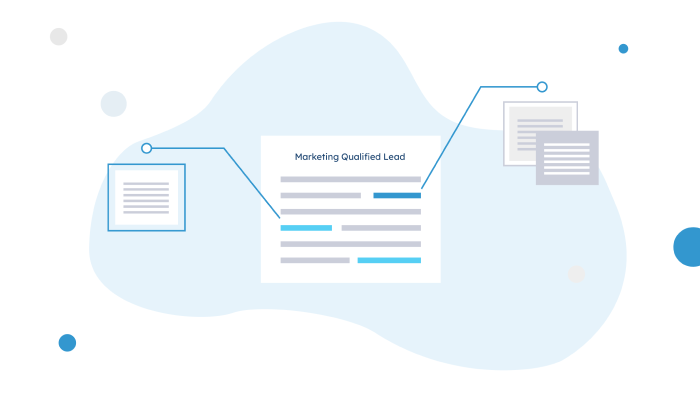What’s the definition of a Marketing Qualified Lead (MQL)? This is one of the most important questions you need to answer as you ramp up your marketing efforts. Your answer doesn’t need to stay the same forever – in fact, it should change as you learn more about your audience and ICP. If you don't get clear on this definition upfront, you can cause a lot of confusion, missed leads, and investment in the wrong efforts.
What defines an MQL?
An MQL is a lead that the marketing team has qualified as having demonstrated intent/interest in your product (based on a set of mutually agreed-upon criteria) and is ready for handoff to the sales team.
Let’s break down each step of the definition so we can understand the meaning of an MQL:
A Marketing Qualified Lead is a lead...
An MQL should be a "Lead" first and foremost, which means it needs to fit your Ideal Customer Profile (ICP). If a lead originates from inbound efforts (contact form, demo request, resource download, ROI calculator submission) the ICP fit can be a little looser. In the case of your outbound efforts (cold email or LinkedIn outreach), good ICP fit is a prerequisite for turning a lead into an MQL. If the lead isn't a good fit, is it really worth spending sales team resources to nurture them down the funnel?
Remember that your ICP may lie on a spectrum. For example, if a lead does not fit your ICP because the company’s revenue range is too high or too low, you may still decide to pursue them. If a lead has positive signals but uses an ERP your product doesn’t integrate with, they may not be worth nurturing. This type of lead can (and should) get disqualified by marketing.
...that the marketing team has qualified as having demonstrated intent and interest in your product (based on a set of mutually agreed-upon criteria)...
Before you build your marketing dashboard, your marketing and sales teams need to align on what it means for a lead to have demonstrated enough intent to be handed off. This will change based on the maturity of your sales function. For example, do you have SDRs and BDRs to help nurture lower-intent leads through the funnel? Or does your team mainly consist of Account Executives who only want to engage with extremely high-intent “hand-raisers”? Determine what criteria make a lead worth handing off to sales – these will differ from company to company.
...and is ready for handoff to the sales team.
This portion of the definition tells us which team takes ownership of further developing the lead down the funnel. If sales accept responsibility for an MQL, they should mark the contact as a SAL (Sales Accepted Lead).
You need to clarify what qualifies a lead as being ready for handoff to sales. These decisions should not be made in isolation—meet and discuss the specific criteria you’ll use to move leads through your marketing and sales funnel. It’s important for marketing to prioritize a fast handoff and for sales to prioritize fast follow-up.
A good goal to aim for is a 5-minute follow-up for hot inbound MQLs.
Better than a manual handoff is immediately routing your prospect to a booking link so they can schedule a demo with one of your sales team members whenever it works best for them. Speed wins, and friction kills in software sales. When a prospect has self-identified their need and is in the market for a solution, you can't waste time.
Just because sales have accepted your lead and taken over primary communications doesn't mean that all marketing communications should stop. You should, however, be careful to avoid overlap marketing and sales messages.
Questions to validate your marketing qualified lead
Here’s are some basic questions to ask before disqualifying a lead at the MQL stage or handing it off to your sales team for follow-up:
- Does the account fit your ideal customer profile (ICP)?
- Are the contact details correct, real, and verified?
- Has the contact expressed interest in getting more information from a salesperson (usually a demo request or
- Is the sales team ready to follow up fast?
How to get sales & marketing alignment on your MQL criteria
Getting your sales and marketing teams to agree on the definition of a lead at each stage can be a challenge. I've found that documenting the entry and exit criteria for each of your funnel stages can be extremely helpful for alignment and precision of language.
Here's an example of a lifecycle stage matrix I've created for this exact thing in the past:
%20(1).webp?width=630&height=351&name=Screenshot%20of%20a%20lifecycle%20stage%20criteria%20matrix%20to%20help%20SaaS%20sales%20and%20marketing%20teams%20define%20an%20MQL%201%20(2)%20(1).webp)
Test your knowledge—some examples in the wild
- A lead who subscribes to your blog and downloads your white paper on “Best practices for Accounts Payable professionals” has shown some interest but might not be ready for a conversation with sales. This may be an industry professional looking for helpful resources who should probably stay in a marketing nurture stream for more development and lead scoring. I'd mark this person as a "Subscriber".
- A lead who downloads one of your case studies has shown a little more interest and indicated that they might be in “search mode,” exploring software options for their company. Depending on your sales resources (and the type of resource the person downloads), you might decide that this demonstrates enough intent to be marked as an MQL. In most cases, I'd define this as a "Lead" – still not quite ready for handoff.
- A lead who submits a request for a custom ROI calculation. This person has demonstrated more intent. They’re likely searching for a solution – and ways to make a case to their team that your solution is the right one. In most cases, I’d argue this is a Marketing Qualified Lead (MQL" and should get elevated to the sales team as long as you can confirm they belong to a serviceable account.
